Ending homelessness action plan: annual report
Annual progress report detailing the progress being made in delivering the work outlined in the Ending Homelessness Together Action Plan.
Annex 1: Homelessness Statistics
Household support needs
To respond well to homelessness we need to understand what people’s individual needs are and we know (Table 1 below) that households assessed as homeless are increasingly likely to report having at least one support need. This underlines the importance of embedding a person-centred approach, and may also indicate a rise in complex situations. We know that resolving homelessness requires much more than simply housing for many people. The range of needs captured in the official statistics demonstrates the importance of joined-up working across housing, health, social care and education services.
Table 1: Identified Support Needs of Homeless Households Scotland 2017-18 to 2018-19
| Support need | 2017/18 | 2018/19 |
|---|---|---|
| Learning disability | 808 | 792 |
| Physical disability | 1,505 | 1,533 |
| Medical condition | 2,815 | 2,873 |
| Drug or alcohol dependency | 3,303 | 3,345 |
| Basic housing management/independent living skills | 6,348 | 6,866 |
| Mental health problem | 6,672 | 7,410 |
| Where at least one support need identified | 13,504 | 14,506 |
Reasons for failing to maintain accommodation
As Table 1 (above) shows, there has been an increase in the number of people who identify a support need when they make a homelessness application. When we look at reasons people give for failing to maintain accommodation, mental health reasons, lack of support from friends/family and financial difficulties are all major reasons given. Whilst the main reason overall is ‘not to do with the applicant household’, 16-17 year old applicants are more likely to give their reason as lack of support from friends/family and over 50s were more likely to say it was due to physical health problems. Couples with children said they had an unmet need for support from housing/social work/health services.
Increases from the previous year to mental health reasons, lack of support and unmet need for support are all particularly concerning. We want to see a reduction in all of these as we build understanding through working in partnership across health, social care and other areas to improve outcomes for people with complex needs.
Chart 2: Reasons for failing to maintain accommodation: Scotland 2018-19
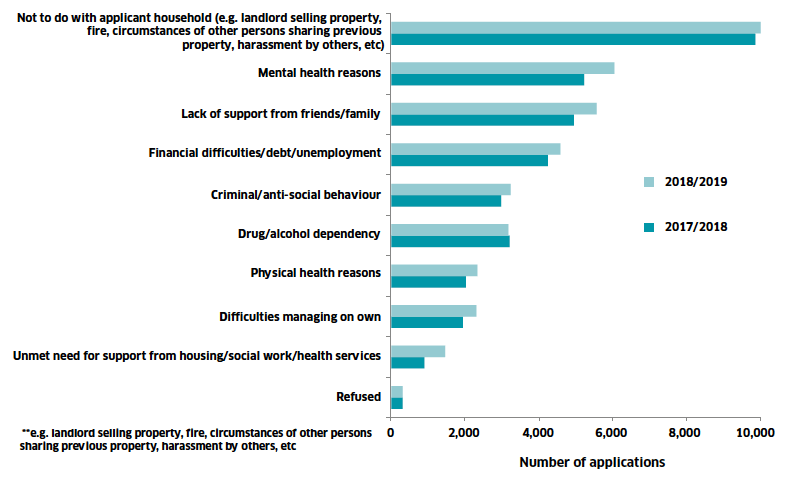
Reasons for homelessness
In designing interventions to prevent homelessness it is crucial we understand the drivers of homelessness.
We know there are a number of different reasons people give when making a homelessness application. The most common reason when looking across all applications is that the applicant was asked to leave their current accommodation (see Chart 3). For younger applicants this is even more likely (over half of applications in this age group).
When we consider gender, for women the most common reason for making an application is a violent or abusive dispute within the household (22% of all female main applicants, compared to 5% of applications from male main applicants). For men the most common reason is ‘asked to leave’.
More people made homelessness applications in 2018/19 (than 2017/18) due to relationship breakdown and violence outside the home and there was a slight drop in the proportion of people being discharged from prison, hospital or care.
Whilst we would hope our focus on prevention will drive reductions in the number of homelessness applications over time, we would expect to see particular decreases among at risk groups for which we are developing prevention pathways, including people experiencing domestic abuse.
Chart 3: Main reason for making homelessness applications
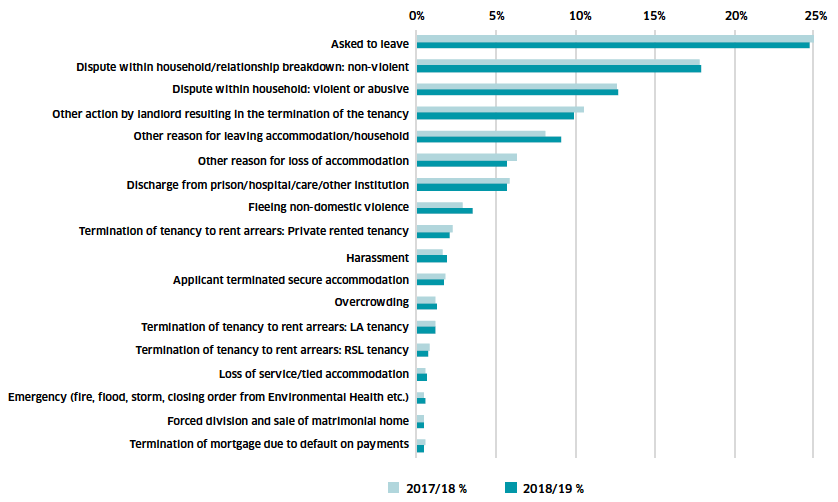
Prior housing circumstances
A further factor in understanding how best to prevent homelessness is to understand people’s living situations before they make a homelessness application. The majority of applicants had either been living with friends or family or owning or renting before making their application (see Chart 4). Younger homelessness applicants are far more likely to have been living with friends than older applicants who were much more likely to have been owning or renting.
Over time as local and national government work together to embed homelessness prevention we expect to see all these numbers decrease. We anticipate that the partnerships we are developing with the wider public sector, including health and justice will lead to a particular reduction in the numbers of those leaving institutional accommodation.
Chart 4: Prior housing circumstances of applicants Scotland 2017/18 to 2018/19
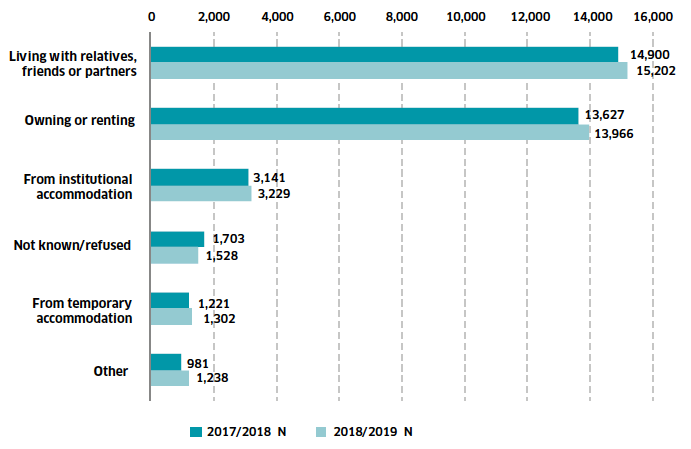
Use of temporary accommodation
Temporary accommodation is a vital safety net for people in emergency situations. The changes to the response to homelessness since devolution have led to a far greater proportion of people facing homelessness being able to access this important protection. Only around 4,000 people were given temporary accommodation in 1995-96, rising to around 11,000 at the time of the abolition of priority need in 2012. However, we recognise that the most effective response to homelessness is to support people back to a settled home of their own in mainstream housing as quickly as possible. That is why we are now seeking to move to a system of rapid rehousing, where there is far less need for any form of temporary accommodation – as well as ensuring that when it is needed, the quality of the accommodation is high, and stays there are short.
The 2018-19 Homelessness Statistics reflect the period to March 2019, just before the Rapid Rehousing Transition Plans developed by every local authority were due to begin implementation. There were 10,989 households in temporary accommodation as at 31 March 2019, an increase of 56 households (1%) since the previous year.
We anticipate the changes we are bringing about to legislation and guidance will help reduce the length of time people stay in temporary accommodation and improve the quality of the accommodation. We also anticipate the implementation of the Rapid Rehousing Transition Plans developed by every local authority, which include plans for Housing First provision throughout Scotland, will result in fewer people needing to be housed in temporary accommodation.
In the early years of implementation, we may see an initial increase in numbers of people in temporary accommodation as people who have previously not engaged with the homelessness system start to come forward for assistance from the local authority. This may lead to a short-term increase in the numbers of households in temporary accommodation. Additionally as people who have been living for longer periods of time in temporary accommodation move into mainstream housing, we recognise that this may also initially increase the average length of stay in temporary accommodation. However it must be recognised we expect this to be short-term and the longer term outcomes of helping more people and increasing the numbers into settled and sustained accommodation in the longer term are what we are aiming for.
As we move to a stronger prevention approach to homelessness, temporary accommodation will no longer be required to the same extent and we anticipate that the numbers across all these categories will reduce. The length of time some households spend in temporary accommodation, bed and breakfast in particular, is not acceptable. We anticipate the extension of the unsuitable accommodation order, a focus on prevention, and implementation of rapid rehousing transition plans will all work together to deliver a significant reduction in the use of bed and breakfast, in particular where it is used for long periods.
In order to understand the impact of these changes, we need to continue to record the number of people in temporary accommodation and the length of time they are staying. We also need to continue to work closely with local authorities to understand the local experience and learning from the changes, and to gather further intelligence of what might lie behind the headline statistics.
Chart 5: Households in Temporary Accommodation at 31 March each year
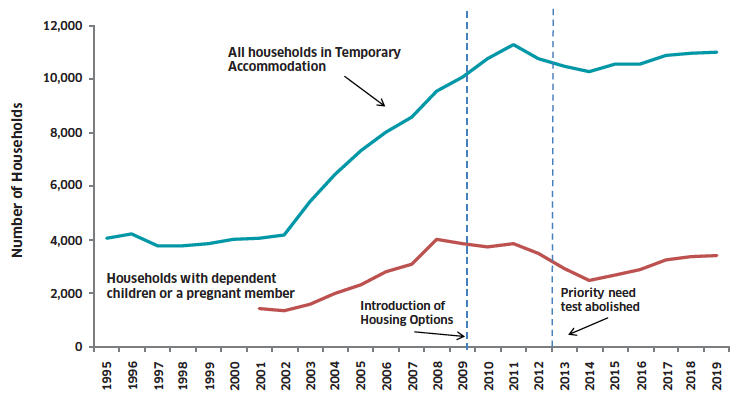
Of these households in temporary accommodation, 3,415 had children or a pregnant member – an increase of 65 households (2%) compared to the same date one year previous, and the fifth consecutive annual increase. The number of children in temporary accommodation increased by 180 children (3%) to 6,795 compared to the same date one year ago, and the fifth consecutive annual increase.
Chart 6 shows that across temporary accommodation placements which ended in 2018/19 the average length of stay can vary by accommodation type. Local authority, housing association and private sector placements are likely to involve longer periods, with hostel placements and in particular bed and breakfast placements tending to be much shorter in length. However, in some cases such placements last for several months and in some cases over a year. And as Chart 7 shows (below) there have been increases across all lengths of stay in temporary accommodation since 2017/18.
Chart 6: Duration in Temporary Accommodation by placement type
Based on the duration of individual placements that ended during 2018/19
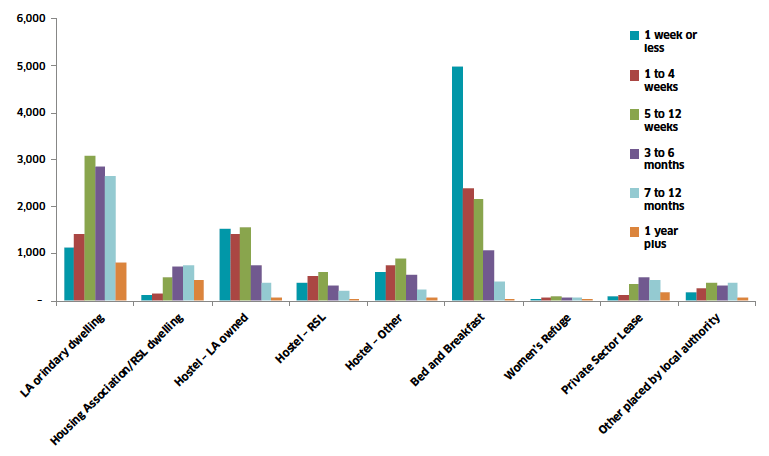
Chart 7: Duration in temporary accommodation Scotland 2017/18 to 2018/19
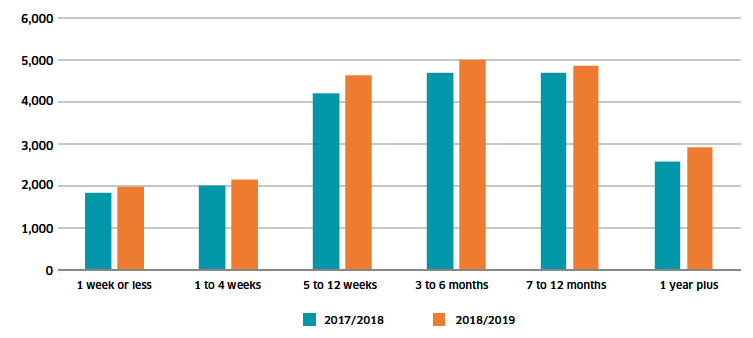
Rough sleeping
A major focus for our work is around preventing rough sleeping, recognising it as the most urgent and severe form of homelessness.
Although the proportion of applications where a household member reported sleeping rough at least once in the 3 months prior to making an application has reduced considerably since 2002/03, since 2014/15 the number has been increasing slightly and the most recent statistics show that 1,643 applicants slept rough the night before applying for assistance. Male applicants are by far the largest group reporting sleeping rough in the previous 3 months.
We are committed to delivering our vision that no-one sleeps rough and we recognise that the most effective, sustainable way to achieve this is not by simply picking people up off the streets and transferring them to temporary accommodation. Instead by focusing on ensuring everyone has a settled home as well as supporting frontline outreach and emergency accommodation to help people access support to help them avoid rough sleeping, or find sustainable routes out of it.
Chart 8: Rough sleeping the night before application – Scotland 2002/03 to 2018/19
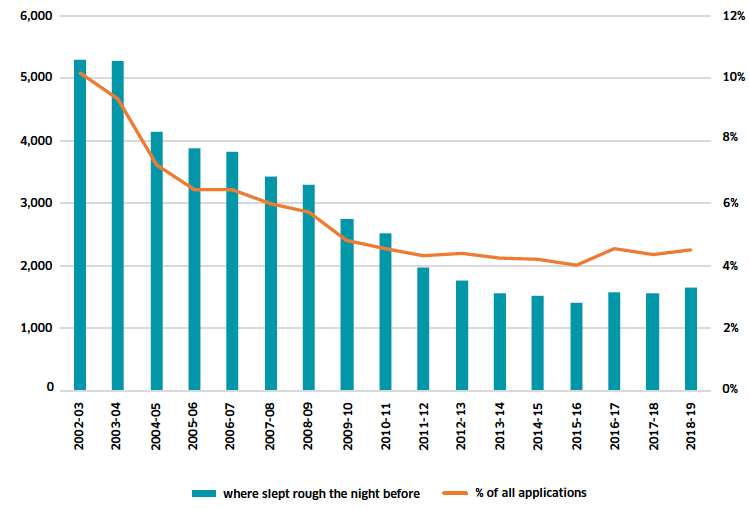
Outcomes
It is important that we know what happens to someone following their homelessness application so we can understand what is working well in our system and tackle issues and barriers effectively.
Since 2002/03 we have seen a steady increase in households securing settled accommodation[17]. We plan to build on this important success with continued efforts to deliver Rapid Rehousing and Housing First. Chart 9 below shows that around 70% of households secured accommodation in 2018/19 compared to fewer than 50% in 2002/03. Older applicants are more likely to secure settled accommodation and younger applicants (particularly aged 16-17) are more likely to move in with friends or family.
Chart 9: Proportion of unintentionally homeless households securing settled accommodation 2002/03 to 2018/19
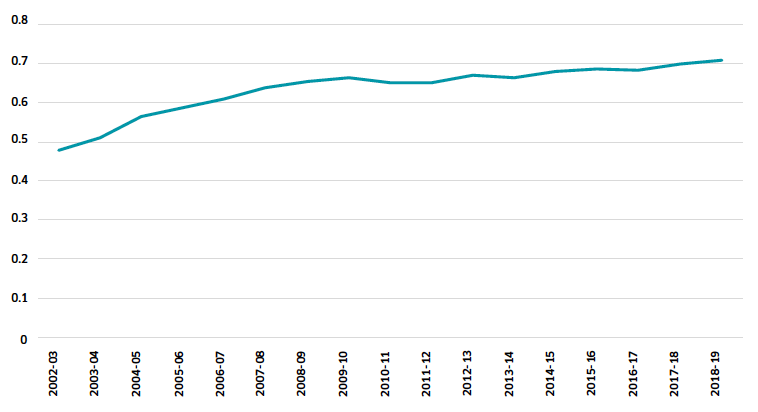
Repeat homelessness
In order to end homelessness we need to ensure that people get the right help to reduce the risk of homelessness happening again. The proportion of repeat homelessness applications reduced significantly between 2002/03 and 2009/10 but we have seen little improvement in the figures since then.
Our ambition to prevent homelessness from happening is even more important when considering people who have already experienced homelessness. We anticipate these proportions reducing over the coming years as we embed person-centred approaches to receiving support and focus on supporting people to maintain settled accommodation.
It is also worth noting there is considerable variation between local authorities in the proportions of repeat homelessness applications they receive (Chart 11 below). There is likely to be much to learn from those local authorities with low proportions of repeat applications and we will explore this through year two of implementation of our Action Plan in 2020.
Chart 10: Scotland: Repeat homelessness applications
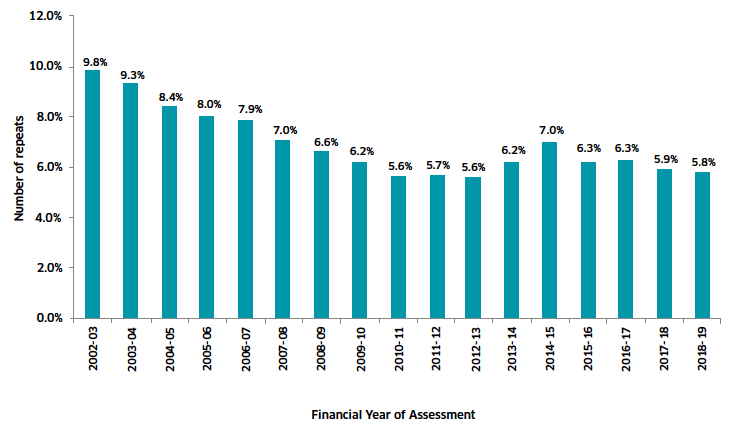
Chart 11: Repeat homelessness by local authority
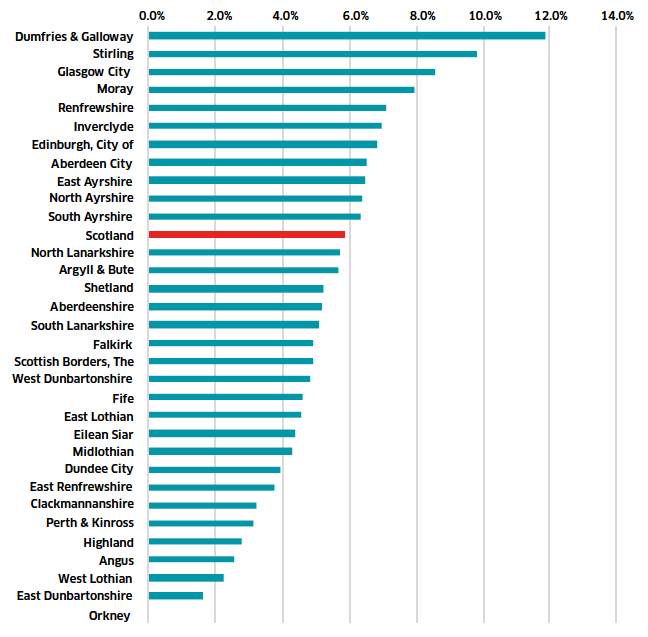
Contact
Email: Ruth.Whatling@gov.scot
There is a problem
Thanks for your feedback